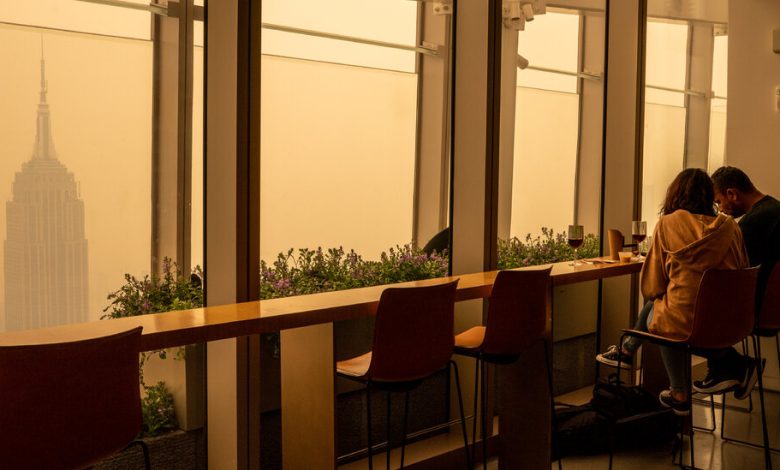Why We’re Still Breathing Dirty Indoor Air

In early 2020, the world scrubbed down surfaces, washed hands and sneezed into elbows, desperate to avoid infection with a new coronavirus. But the threat was not really lying on countertops and doorknobs.
The virus was wafting through the air, set adrift in coughs and conversation, even in song. The pandemic raged for six months before global health authorities acknowledged that it was driven by an airborne pathogen.
With that revelation came another: Had indoor air quality ever been a priority, the pandemic would have exacted a far lighter toll in the United States.
More than three years later, little has changed. Most Americans are still squeezing into offices, classrooms, restaurants and shops with inadequate, often decrepit ventilation systems, often in buildings with windows sealed shut.
Scientists agree that the next pandemic will almost certainly arise from another airborne virus. But improving air quality isn’t just about fighting infectious diseases: Indoor pollution can damage the heart, lungs and brain, shortening life spans and lowering cognition.
And wildfires, outdoor air pollution and climate change will quickly preclude Band-Aid solutions, like simply opening windows or pumping in more air from outside.
Instead, the nation will have to begin to think about the indoor air — in schools, restaurants, offices, trains, airports, movie theaters — as an environment that greatly influences human health. Improving it will require money, scientific guidance on how clean the air needs to be and, most crucially, political will to compel change.
“The push for clean water is considered one of the 10 biggest public health advances of the last century, and air should be no different,” said Linsey Marr, an expert in airborne transmission of viruses at Virginia Tech.
Federal and state laws govern the quality of water, food and outdoor pollution, but there are no regulations for indoor air quality overall, only scattershot limits on a few pollutants. Nor does any single federal agency or official champion the cause.
Without building codes or laws to enforce them, efforts to address air quality have so far been patchy. Some cities, school districts and businesses have forged ahead on their own. But by and large, Americans are still breathing the indoor air that set the stage for the pandemic.
“Everyone just does the minimum,” said Shelly Miller, an aerosol expert at the University of Colorado Boulder.
The real obstacle now, experts said in interviews, is the lack of leadership — a federal agency or even a ventilation czar to enforce recommendations and set the nation on a long-needed course to improve indoor air quality.
“To achieve real change that reaches a broad swath of the population,” Dr. Marr said, “we need standards to be incorporated into building codes and laws at the state and federal level.”
Two new sets of recommendations may begin to usher in change. In May, the Centers for Disease Control and Prevention recommended five so-called air changes per hour — the equivalent of replacing all the air in a room — in all buildings, including schools.
The American Society of Heating, Refrigerating and Air-Conditioning Engineers, an association of air quality experts, went further, proposing a recommendation of more than eight air changes.
Both sets of guidelines also offer clarity on air quality monitors and upgrades to air filters and ventilation systems.
“It’s a huge leap,” Dr. Marr said, “because it’s the first time, outside of hospitals and specialized workplaces, we have seen some kind of indoor air target that is based on health rather than just thermal comfort or energy considerations.”
A Paradigm Shift
Indoor air quality might have taken center stage sooner if the medical establishment had not firmly believed that respiratory diseases like influenza spread almost exclusively through large respiratory droplets that are expelled when a person coughs or sneezes.
The idea may have been fueled by observations that people who were closest to a sick person seemed most at risk of infection. That led medical experts to recommend hand washing and social distancing as the best ways to contain a respiratory virus.
But scientists showed decades ago that large droplets may evaporate and shrink as they are expelled, becoming tiny aerosols that linger in the air. That is, a patient with the flu isn’t just expelling the virus in large droplets. According to Yuguo Li, an air quality expert at the University of Hong Kong, that patient may exhale, cough or sneeze droplets in any number of sizes.
The smallest will drift through the air and be inhaled directly into the lungs — a scenario that requires precautions far different than wiping down surfaces or washing hands.
To Dr. Li and other air quality experts, it was obvious from the start of the pandemic that the coronavirus was carried aloft. The SARS coronavirus, a close relative that emerged in Asia in 2002, was airborne — why would the new one be any different?
In January 2020, Chinese researchers described a cluster of infections that included a 10-year-old child who had no symptoms but whose scans revealed “ground-glass lung opacities,” a sign of infection with the new coronavirus.
Dr. Donald K. Milton of the University of Maryland, who has studied respiratory virus transmission for decades, knew what that meant: The coronavirus was being inhaled into the lungs.
“If an asymptomatic kid can have that going on in his lungs, it’s going to be very difficult to contain, because asymptomatic people are going to be contagious,” Dr. Milton recalled thinking when the Chinese report came out.
Other evidence for airborne transmission quickly piled up. There was a New York man who became infected simply by driving his neighbor to the hospital, the 712 infected passengers and crew members of the Diamond Princess cruise ship, a choir practice in Seattle, and diners at a restaurant in China.
Still, the erroneous distinction between large and small droplets remained entrenched, despite attempts from physicists and air quality experts to set the record straight.
“The resistance was thick. The walls of the silo were thick,” said Richard Corsi, dean of the College of Engineering at the University of California, Davis. “I’ll be blunt, it’s been frustrating as hell from the very start.”
Some scientists felt the health agencies were stonewalling because the consequences of indoor aerosol transmission — high-quality masks, air filtration, building closures — would require a herculean response.
William Bahnfleth, an architectural engineering expert at Penn State University, said he was shocked by “the paralysis of the public health community, the demand for more and more conclusive data.”
It took the C.D.C. until April 2020 to recommend masking and until October 2020 to acknowledge aerosol transmission of the coronavirus, and even then only obliquely. The World Health Organization was forced to review its stance in July 2020, after 239 experts issued a statement demanding it.
A watershed moment came in the spring of 2021, when three major medical journals published papers on airborne transmission of the coronavirus.
Still, the W.H.O. did not use the word “airborne” to describe the virus until December 2021, and the C.D.C. has yet to do so.
“I worked with them on editing the scientific brief on transmission, and it was clear that they did not want to use the word,” Dr. Marr said of the C.D.C. “It’s maddening.”
‘Health and Happiness’
Respiratory viruses aren’t the only reason to clean the air indoors.
Indoor air pollution — from wildfire smoke that infiltrates homes, building materials like asbestos, gases like radon or even fumes from cleaning supplies — affects the heart, lungs and the brain, contributing to chronic illnesses like asthma and diabetes.
Elevated carbon dioxide in crowded rooms can cause drowsiness and loss of concentration, leading to poor academic performance. Improved air quality can reduce absenteeism, in schools and in offices.
“Improving indoor air quality pays for itself, in benefits to both the economy and to human health and happiness,” said Brian Fleck, an air quality expert at the University of Alberta in Canada. “It’s always surprising how things known for a very long time are still not acted upon.”
As the pandemic unfolded, some schools and businesses coped by simply opening windows. But with wildfires, soaring temperatures and rising air pollution, that will cease to be a practical option — indeed, it already has in many parts of the world.
The better solution is to clean the air already indoors.
Experts generally agree that the air in a room should be replaced six to eight times an hour. For an average-size room, air purifiers that cost a few hundred dollars can accomplish that goal.
Some schools have even successfully turned to homemade $100 contraptions of box fans that are taped to air filters. Ultraviolet light is an energy-efficient and powerful way to kill pathogens, and there are newer versions that are not harmful to people.
But a far-reaching campaign to clean America’s indoor air has not yet happened. In California, the minimum recommended standard is six changes per hour. But in one study, 93 percent of schools fell below that standard.
It’s not that there has been no discussion of fresh air.
The Biden administration’s pandemic preparedness plan, published in September 2021, included support of new technology to provide “pathogen protection within the built environment” and investments for retrofitting older buildings.
In March 2022, the Environmental Protection Agency announced the Clean Air in Buildings Challenge, which includes a checklist for better ventilation, to encourage building administrators to take air quality seriously. And in October 2022, the White House held a summit on indoor air quality, calling on business and school leaders to make improvements to mitigate the spread of Covid.
A life sciences team within the White House Office of Science and Technology Policy — the first under any administration — is coordinating efforts to improve indoor air quality with various arms of the government.
But none of these efforts has yet coalesced into anything like a rigorous national plan.
For once, money does not appear to be the barrier. The American Rescue Plan allotted$350 billionto state and local governments for Covid-related expenses, including measures to improve air quality. Schools can tap another $200 billion from various programs instituted during the pandemic.
For private businesses, even an investment of just $40 per employee could save about $7,000 per person per year, according to Joseph Allen, director of the Healthy Buildings program at the Harvard T.H. Chan School of Public Health.
But widespread change is unlikely unless a federal agency or official is tasked with establishing and enforcing standards, many scientists believe.
“The problem is there’s no regulatory authority to make this happen on the federal level,” said David Michaels, who led the Occupational Safety and Health Administration under President Barack Obama.
The E.P.A. has authority over outdoor air and specific pollutants like asbestos, lead and radon. OSHA has no rules on airborne infections, and an attempt in the 1990s to regulate air quality was quickly quashed by the tobacco industry.
The C.D.C. can offer recommendations on indoor air but not rules, and it does not venture far into ventilation practices and standards.
Still, the agency’s new guidelines may make it easier for people and businesses to recognize and demand better air quality. At least in theory, they may also enable OSHA to hold employers responsible for maintaining clean air, Dr. Michaels said.
“It helps OSHA if they want to directly address particular problems now, but it’s sort of a road map to future indoor air quality standards,” he said.
Dr. Allen noted that the move toward clean water came in fits and starts over decades, and changes to ventilation, too, may take a long time to unspool.
“The next pandemic, whatever it is, buildings will be part of the core response on Day 1,” he said. “I don’t have any doubt about that.”




